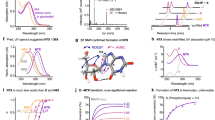Play all audios:

ABSTRACT IN a nucleoside the rotation of the nucleobase about the glycosidic bond relative to the sugar moiety is sterically hindered and two conformational ranges, _syn_ and _anti_, are
preferred1. Theoretical2–5 and spectroscopic6–8 investigations suggest that the _anti_ conformation is slightly more energetically favoured than the _syn_. In the crystalline state, this is
also true for purine nucleosides but all pyrimidine nucleosides, except 4-thiouridine9 (a tRNA minor constituent), crystallize in _anti_ conformation. 4-Thiouridine may occur in _syn_
conformation because of the stabilization by the peculiar hydrogen bonding and packing scheme or the particular C(3′)-endo-C(4′)-exo puckering* of the ribose unit. The correlation between
conformation about the glycosidic bond and the sugar puckering in nucleosides was further studied by X-ray analysis of 6-methyluridine (Fig. 1). This species, according to nuclear magnetic
resonance studies6, exists in the _syn_ conformation in aqueous solution because of the bulky methyl group in position 6 of the pyrimidine ring. Access through your institution Buy or
subscribe This is a preview of subscription content, access via your institution ACCESS OPTIONS Access through your institution Subscribe to this journal Receive 51 print issues and online
access $199.00 per year only $3.90 per issue Learn more Buy this article * Purchase on SpringerLink * Instant access to full article PDF Buy now Prices may be subject to local taxes which
are calculated during checkout ADDITIONAL ACCESS OPTIONS: * Log in * Learn about institutional subscriptions * Read our FAQs * Contact customer support SIMILAR CONTENT BEING VIEWED BY OTHERS
NUCLEOSIDE PHOSPHORYLASES MAKE _N_7-XANTHOSINE Article Open access 29 April 2024 UNMASKING THE HALIDE EFFECT IN DIASTEREOSELECTIVE GRIGNARD REACTIONS APPLIED TO C4´ MODIFIED NUCLEOSIDE
SYNTHESIS Article Open access 16 February 2025 REGIOSELECTIVE RIBONUCLEOSIDE SYNTHESIS THROUGH TI-CATALYSED RIBOSYLATION OF NUCLEOBASES Article 09 January 2023 REFERENCES * Donohue, J., and
Trueblood, K. N., _J. Mol. Biol._, 2, 363 (1960). Article CAS Google Scholar * Haschemeyer, A. E. V., and Rich, A., _J. Mol. Biol._, 27, 369 (1967). Article CAS Google Scholar *
Lakshminarayanan, A. V., and Sasisekharan, V., _Biochim. Biophys. Acta_, 204, 49 (1970). Article CAS Google Scholar * Berthod, H., and Pullman, B., _Biochim. Biophys. Acta_, 232, 595
(1971). Article CAS Google Scholar * Kang, S., _J. Mol. Biol._, 58, 297 (1971). Article CAS Google Scholar * Schweizer, M. P., Witkowski, J. T., and Robins, R. K., _J. Amer. Chem.
Soc._, 93, 277 (1971). Article CAS Google Scholar * Hart, P. A., and Davis, J. P., _J. Amer. Chem. Soc._, 91, 512 (1969). Article CAS Google Scholar * Rogers, G. T., and Ulbricht, T.
L. V., _Biochem. Biophys. Res. Commun._, 39, 419 (1970). Article CAS Google Scholar * Saenger, W., and Scheit, K. H., _J. Mol. Biol._, 50, 153 (1970). Article CAS Google Scholar *
Karle, J., and Hautpman, H., _Acta Cryst._, 9, 635 (1956). Article MathSciNet CAS Google Scholar * Germain, G., Main, P., and Woolfson, M. M., _Acta Cryst._, B 26, 274 (1970) and A 27,
368 (1971). Article CAS Google Scholar * Saenger, W., and Eckstein, F., _J. Amer. Chem. Soc._, 92, 4712 (1970). Article CAS Google Scholar * Rao, S. T., and Sundaralingam, M., _J.
Amer. Chem. Soc._, 92, 4963 (1970). Article CAS Google Scholar * Saenger, W., _J. Amer. Chem. Soc._, 93, 3035 (1971). Article CAS Google Scholar Download references AUTHOR INFORMATION
AUTHORS AND AFFILIATIONS * Max-Planck-Institut für Experimentelle Medizin, Abteilung Chemie, 34, Göttingen D. SUCK & W. SAENGER * Schering AG, 1, Berlin H. VORBRÜGGEN Authors * D. SUCK
View author publications You can also search for this author inPubMed Google Scholar * W. SAENGER View author publications You can also search for this author inPubMed Google Scholar * H.
VORBRÜGGEN View author publications You can also search for this author inPubMed Google Scholar RIGHTS AND PERMISSIONS Reprints and permissions ABOUT THIS ARTICLE CITE THIS ARTICLE SUCK, D.,
SAENGER, W. & VORBRÜGGEN, H. Conformation of 6-Methyluridine — a Pyrimidine Nucleoside in the _syn_ Conformation. _Nature_ 235, 333–334 (1972). https://doi.org/10.1038/235333a0 Download
citation * Received: 24 August 1971 * Issue Date: 11 February 1972 * DOI: https://doi.org/10.1038/235333a0 SHARE THIS ARTICLE Anyone you share the following link with will be able to read
this content: Get shareable link Sorry, a shareable link is not currently available for this article. Copy to clipboard Provided by the Springer Nature SharedIt content-sharing initiative
